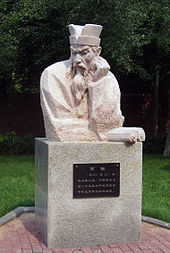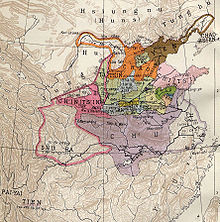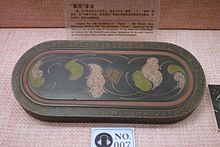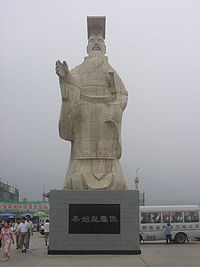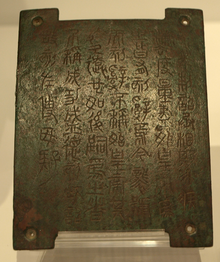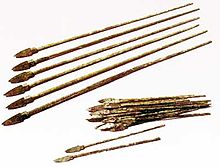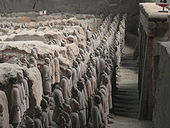- Qin Dynasty
-
Not to be confused with the Qing Dynasty, the last dynasty of Imperial China.
Qin
秦← 
←
221 B.C.E–206 B.C.E  →
→
 →
→The Qin Dynasty circa. 210 BC Capital Xianyang Language(s) Old Chinese Religion Chinese folk religion, Legalism Government Monarchy Emperor - 221 BC–210 BC Qin Shihuang - 210 BC–207 BC Qin Er Shi Chancellor - 221 BC–208 BC Li Si - 208 BC–207 BC Zhao Gao History - Unification of China 221 B.C.E - Death of Qin Shihuang 210 BC - Surrender to Liu Bang 206 B.C.E Population - 210 BC est. 20,000,000 Currency Ban liang coins History of China ANCIENT 3 Sovereigns and 5 Emperors Xia Dynasty 2100–1600 BC Shang Dynasty 1600–1046 BC Zhou Dynasty 1045–256 BC Western Zhou Eastern Zhou Spring and Autumn Period Warring States Period IMPERIAL Qin Dynasty 221 BC–206 BC Han Dynasty 206 BC–220 AD Western Han Xin Dynasty Eastern Han Three Kingdoms 220–280 Wei, Shu and Wu Jin Dynasty 265–420 Western Jin 16 Kingdoms
304–439Eastern Jin Southern and Northern Dynasties
420–589Sui Dynasty 581–618 Tang Dynasty 618–907 (Second Zhou 690–705) 5 Dynasties and
10 Kingdoms
907–960Liao Dynasty
907–1125Song Dynasty
960–1279Northern Song W. Xia Southern Song Jin Yuan Dynasty 1271–1368 Ming Dynasty 1368–1644 Qing Dynasty 1644–1911 MODERN Republic of China 1912–1949 People's Republic
of China
1949–presentRepublic of
China (Taiwan)
1949–presentRelated articlesThe Qin Dynasty (Chinese: 秦朝; pinyin: Qín Cháo; Wade–Giles: Ch'in Ch'ao; IPA: [tɕʰǐn tʂʰɑ̌ʊ̯]) was the first imperial dynasty of China, lasting from 221 to 207 BC. The Qin state derived its name from its heartland of Qin, in modern-day Shaanxi. The strength of the Qin state was greatly increased by the legalist reforms of Shang Yang in the 4th century BC, during the Warring States Period. In the mid and late third century BC, the Qin accomplished a series of swift conquests, first ending the powerless Zhou Dynasty, and eventually destroying the remaining six states of the major states to gain control over the whole of China, resulting in a unified China.
During its reign over China, the Qin Dynasty achieved increased trade, improved agriculture, and military security. This was due to the abolition of landowning lords, to whom peasants had formerly held allegiance. The central government now had direct control of the masses, giving it access to a much larger workforce. This allowed for the construction of ambitious projects, such as a wall on the northern border, now known as the Great Wall of China. The Qin Dynasty also introduced several reforms: currency, weights and measures were standardized, and a better system of writing was established. An attempt to purge all traces of the old dynasties led to the infamous burning of books and burying of scholars incident, which has been criticized greatly by subsequent scholars. The Qin's military was also revolutionary in that it used the most recently developed weaponry, transportation, and tactics, though the government was heavy-handed and bureaucratic.
Despite its military strength, the Qin Dynasty did not last long. When the first emperor died in 210 BC, his son was placed on the throne by two of the previous emperor's advisers, in an attempt to influence and control the administration of the entire dynasty through him. The advisors squabbled among themselves, however, which resulted in both their deaths and that of the second Qin emperor. Popular revolt broke out a few years later, and the weakened empire soon fell to a Chu lieutenant, who went on to found the Han Dynasty.[note 1] Despite its rapid end, the Qin Dynasty influenced future Chinese empires, particularly the Han, and the European name for China is thought to be derived from it.[citation needed]
Contents
History
See also: Qin (state)Origins and early development
Feizi, a descendant of the ancient political advisor Gao Yao, was granted rule over Qin City.[note 2] During the rule of King Xiao of Zhou, the eighth king of the Zhou Dynasty, this area became known as the state of Qin. In 897 BC, under the regency of Gonghe, the area became a dependency allotted for the purpose of raising and breeding horses.[1] One of Feizi's descendants, Duke Zhuang, became favoured by King Ping of Zhou, the thirteenth king in that line. As a reward, Zhuang's son, Duke Xiang, was sent eastward as the leader of a war expedition, during which he formally established the Qin.[2]
Qin state first sent a military expedition into central China in 672 BC, though it did not engage in any serious incursions due to the threat from neighbouring tribesmen. By the dawn of the fourth century BC, however, the neighbouring tribes had all been either subdued or conquered, and the stage was set for the rise of Qin expansionism.[3]
Growth of power
Lord Shang Yang, a Qin statesman, introduced a number of militarily advantageous reforms from 361 BC until his death in 338 BC, and also helped construct the Qin capital, Xianyang. This latter accomplishment commenced in the mid-fourth century BC; the resulting city greatly resembled the capitals of other Warring States.[4]
Of Shang Yang's reforms, the most notable one was advocating the philosophy of Legalism, which encouraged practical and ruthless warfare.[5] In contrast, during the Zhou Dynasty and the ensuing Warring States Period, the prevalent philosophy had dictated war as a gentleman's activity; military commanders were instructed to respect what they perceived to be Heaven's laws in battle.[6] For example, during the Warring States Period, Duke Xiang of Song[note 3] was at war with the state of Chu, and had an opportunity to attack the enemy force, commanded by Zhu, while they were crossing a river. Instead, however, he waited for them to finish crossing, and allowed them to marshal their forces. He was decisively defeated in the ensuing battle, and when, later, his advisors admonished him for such excessive courtesy to the enemy, he retorted, "The sage does not crush the feeble, nor give the order for attack until the enemy have formed their ranks."[6] The Qin disregarded this military tradition, taking advantage of their enemy's weaknesses. A nobleman in the state of Wei accused the Qin state of being "avaricious, perverse, eager for profit, and without sincerity. It knows nothing about etiquette, proper relationships, and virtuous conduct, and if there be an opportunity for material gain, it will disregard its relatives as if they were animals."[7] It was this Legalist thought combined with strong leadership from long-lived rulers, openness to employ talented men from other states, and little internal opposition that gave the Qin such a strong political base.[8]
Another advantage of the Qin was that they had a large, efficient army[note 4] and capable generals. They utilised the newest developments in weaponry and transportation as well, which many of their enemies lacked. These latter developments allowed greater mobility over several different terrain types[note 5] which were most common in many regions of China. Thus, in both ideology and practice, the Qin were militarily superior.[5]
Finally, the Qin empire had a geographical advantage due to its fertility and strategic situation, protected by mountains that made the state a natural stronghold.[note 6] Its expanded agricultural output helped sustain Qin's large army with food and natural resources;[8] the Wei River canal built in 246 BC was particularly significant in this respect.[9]
Conquest of other states
Main article: Qin's wars of unificationDuring the Warring States Period preceding the Qin Dynasty, the major states vying for dominance were Yan, Zhao, Qi, Chu, Han, Wei and Qin. The rulers of these states styled themselves as kings, rather than using the titles of lower nobility they had previously held. However, none elevated himself to believe that he had the "Mandate of Heaven," as the Zhou emperors had claimed, nor that he had the right to offer sacrifices—they left this to the Zhou rulers.[10]
A Chinese lacquerware box with the "Panyu" name on its surface, one piece of evidence that the Qin Dynasty governed the area of Guangzhou before the Nanyue Kingdom did
Before their conquest in the fourth and third centuries BC, the Qin suffered several setbacks. Shang Yang was executed in 338 BC due to a grudge by the leader King Wu over a student who had been executed because of Shang Yang's insistence that law applied even to nobility. There was also internal strife over the Qin succession in 307 BC, which decentralised Qin authority somewhat. Qin was defeated by an alliance of the other states in 295 BC, and shortly after suffered another defeat by the state of Zhao, because the majority of their army was then defending against the Qi. The aggressive statesman Fan Sui (范雎), however, soon came to power as prime minister even as the problem of the succession was resolved, and he began an expansionist policy that had originated in Jin and Qi, which prompted the Qin to attempt to conquer the other states.[11]
The Qin were swift in their assault on the other states. They first attacked the Han, directly east, and took the city of Yangdi in 230 BC. They then struck northward; the state of Zhao surrendered in 228 BC, and the northernmost state of Yan followed, falling in 226 BC. Next, Qin armies launched assaults to the east, and later the south as well; they took the Wei city of Daliang (now called Kaifeng) in 225 BC and forced the Chu to surrender by 223 BC. Lastly, they deposed the Zhou Dynasty's remnants in Luoyang and conquered the Qi, taking the city of Linzi in 221 BCE.[11]
Dominion of China
When the conquests were complete in 221 BC, King Zheng[note 7] – who had first assumed the throne of the Qin state at age 13[12] – became the effective ruler of China. He solidified his position as sole ruler with the abdication of his prime minister, Lu Buwei. He then combined the titles of the earlier Three Sovereigns and Five Emperors into his new name: Shi Huangdi (始皇帝) or "First Emperor".[13][note 8] The newly declared emperor ordered all weapons not in the possession of the Qin to be confiscated and melted down. The resulting metal was sufficient to build twelve large ornamental statues at the Qin's newly declared capital, Xianyang.[14]
In 214 BC Qin Shihuang secured his boundaries to the north with a fraction (100,000 men) of his large army, and sent the majority (500,000 men) south to seize still more land. Prior to the events leading to Qin dominance over China, they had gained possession of much of Sichuan to the southwest. The Qin army was unfamiliar with the jungle terrain, and it was defeated by the southern tribes' guerrilla warfare tactics with over 100,000 men lost. However, in the defeat Qin was successful in building a canal to the south, which they used heavily for supplying and reinforcing their troops during their second attack to the south. Building on these gains, the Qin armies conquered the coastal lands surrounding Guangzhou,[note 9] and took the provinces of Fuzhou and Guilin. They struck as far south as Hanoi. After these victories in the south, Qin Shihuang moved over 100,000 prisoners and exiles to colonize the newly conquered area. In terms of extending the boundaries of his empire, the First Emperor was extremely successful in the south.[14]
However, while the empire at times was extended to the north, the Qin could rarely hold on to the land for long. The tribes of these locations, collectively called the Hu by the Qin, were free from Chinese rule during the majority of the Dynasty.[15] Prohibited from trading with Qin Dynasty peasants, the Xiongnu tribe living in the Ordos region in northwest China often raided them instead, prompting the Qin to retaliate. After several campaigns and much effort, the region was conquered and agriculture was established; the peasants, however, were discontented and later revolted. The succeeding Han Dynasty also expanded into the Ordos due to overpopulation, but depleted their resources in the process. Owen Lattimore said of both Dynasties' attempts to conquer the Ordos, "conquest and expansion were illusory. There was no kind of success that did not create its own reaction."[16] Indeed, this was true of the dynasty's borders in multiple directions; modern Xinjiang, Tibet, Manchuria, Inner Mongolia, and regions to the southeast were foreign to the Qin, and even areas over which they had military control were culturally distinct.[17]
Fall from power
Three assassination attempts were made on Qin Shihuang's life,[18] leading him to become paranoid and obsessed with immortality. He died in 210 BC, while on a trip to the far eastern reaches of his empire in an attempt to procure an elixir of immortality from Taoist magicians, who claimed the elixir was stuck on an island guarded by a sea monster. The chief eunuch, Zhao Gao, and the prime minister, Li Si, hid the news of his death upon their return until they were able to alter his will to place on the throne the dead emperor's most pliable son, Huhai, who took the name of Qin Er Shi.[12] They believed that they would be able to manipulate him to their own ends, and thus effectively control the empire. Qin Er Shi was, indeed, inept and pliable. He executed many ministers and imperial princes, continued massive building projects (one of his most extravagant projects was lacquering the city walls), enlarged the army, increased taxes, and arrested messengers who brought him bad news. As a result, men from all over China revolted, attacking officials, raising armies, and declaring themselves kings of seized territories.[19]
During this time, Li Si and Zhao Gao fell out among themselves, and Li Si was executed. Zhao Gao decided to force Qin Er Shi to commit suicide due to Qin Er Shi's incompetence. Upon this, Ziying, a nephew of Qin Er Shi, ascended the throne, and immediately executed Zhao Gao.[19] Ziying, seeing that increasing unrest was growing among the people[note 10] and that many local officials had declared themselves kings, attempted to cling to his throne by declaring himself one king among all the others.[9] He was undermined by his ineptitude, however, and popular revolt broke out in 209 BC. When Chu rebels under the lieutenant Liu Bang attacked, a state in such turmoil could not hold for long. Ziying was defeated near the Wei River in 207 BC and surrendered shortly after; he was executed by the Chu leader Xiang Yu. The Qin capital was destroyed the next year, and this is considered by Derk Bodde, as well as other historians, to be the end of the Qin empire.[20][note 1] Liu Bang then betrayed and defeated Xiang Yu, declaring himself Emperor Gaozu[note 11] of the new Han Dynasty.[21] Despite the short duration of the Qin Dynasty, it was very influential on the structure of future dynasties.
Culture and society
Domestic life
The aristocracy of the Qin were largely similar in their culture and daily life. Regional variations in culture were considered a symbol of the lower classes. This idea stemmed from the Zhou and was seized upon by the Qin, as such variations were seen as contrary to the unification that the government strove to achieve.[22]
Commoners and rural villagers, who made up over 90% of the population,[23] very rarely left the villages or farmsteads where they were born. Common forms of employment differed by region, though farming was almost universally common. Professions were hereditary; a father's employment was passed to his eldest son after he died.[24] The Lüshi Chunqiu[note 12] gave examples of how, when commoners are obsessed with material wealth, instead of the idealism of a man who "makes things serve him", they were "reduced to the service of things".[25]
Peasants were rarely figured in literature during the Qin Dynasty and afterwards; scholars and others of more elite status preferred the excitement of cities and the lure of politics. One notable exception to this was Shen Nong, the so-called "Divine Father", who taught that households should grow their own food. "If in one's prime he does not plow, someone in the world will grow hungry. If in one's prime she does not weave, someone in the world will be cold." The Qin encouraged this; a ritual was performed once every few years that consisted of important government officials taking turns with the plow on a special field, to create a simulation of government interest and activity within agriculture.[24]
Architecture
Warring States-era architecture had several definitive aspects. City walls, used for defense, were made longer, and indeed several secondary walls were also sometimes built to separate the different districts. Verticality in federal structures was emphasised, to create a sense of authority and absolute power. Architectural elements such as high towers, pillar gates, terraces, and high buildings amply conveyed this.[26]
Philosophy and literature
The written language of the Qin was logographic, as that of the Zhou had been.[27] As one of his most influential achievements in life, prime minister Li Si standardized the writing system to be of uniform size and shape across the whole country. This would have a unification effect on the Chinese culture for thousands of years. He is also credited with creating the "lesser-seal" (Chinese: 小篆, Pinyin: xiǎozhuàn) style of calligraphy, which serves as a basis for modern Chinese and is still used in cards, posters, and advertising.[28]
During the Warring States Period, the Hundred Schools of Thought comprised many different philosophies proposed by Chinese scholars. In 221 BC, however, the First Emperor conquered all of the states and governed with a single philosophy, Legalism. At least one school of thought, Mohism, was eradicated, though the reason is not known. Despite the Qin's state ideology and Mohism being similar in certain regards, it is possible that Mohists were sought and killed by the state's armies due to paramilitary activities.[29]
Confucius's school of thought, called Confucianism, was also influential during the Warring States Period, as well as throughout much of the later Zhou Dynasty and early imperial periods.[note 13] This school of thought had a so-called Confucian canon of literature, known as the "six classics": the Odes, Documents, Ritual, Music, Spring and Autumn Annals, and Changes, which embodied Chinese literature at the time.[30]
During the Qin Dynasty, Confucianism--along with all other non-Legalist philosophies--was suppressed by the First Emperor; early Han Dynasty emperors did the same. Legalism denounced the feudal system and encouraged severe punishments, particularly when the emperor was disobeyed. Individuals' rights were devalued when they conflicted with the government's or the ruler's wishes, and merchants and scholars were considered unproductive, fit for elimination.[31] One of the more drastic measures employed to accomplish the eradication of the old schools of thought was the infamous burning of books and burying of scholars incident, which almost singlehandedly gave the Qin Dynasty a bad reputation among later scholars.[14] The First Emperor, in an attempt to consolidate power, ordered the burning of all books on non-Legalist philosophical viewpoints and intellectual subjects.[32] This decree was passed in 213 BC, and also stipulated that all scholars who refused to submit their books to be burned would be executed by premature burial.[14] Only texts considered productive by Legalists were preserved, most on pragmatic subjects, such as agriculture, divination, and medicine.[32] However, controversy remains about the “burning of books and burying of scholars”. Nowadays, many Sinologists argue that the “burying of scholars”, as recorded in Grand Historian, slanders the First Emperor and is not true.[33]
Government and military
The Qin government was highly bureaucratic, and was administered by a hierarchy of officials, all serving the First Emperor. The Qin put into practice the teachings of Han Fei, allowing the First Emperor to control all of his territories, including those recently conquered. All aspects of life were standardized, from measurements and language to more practical details, such as the length of chariot axles.[13] Zheng and his advisers also introduced new laws and practices that ended feudalism in China, replacing it with a centralized, bureaucratic government. Under this system, both the military and government thrived, as talented individuals could be more easily identified in the transformed society. Later Chinese dynasties emulated the Qin government for its efficiency, despite its being condemned by Confucian philosophy.[13][34] Such a system, however, could be manipulated by power-hungry individuals; one example of such an occurrence was documented in the "Records of Officialdom". A commander named Hu ordered his men to attack peasants, in an attempt to increase the number of "bandits" he had killed; his superiors, likely eager to inflate their records as well, allowed this.[35]
Qin Shihuang also improved the military, despite the fact that it had already undergone extensive reforms.[36] The military used the most advanced weaponry of the time. The invention of the sword during the Warring States Period was a great advance. It was first used mostly in bronze form, but by the third century BC, the Qin were using stronger iron swords. The demand for metal this produced resulted in improved bellows. The crossbow had been introduced in the fifth century BC and was more powerful and accurate than the composite bows used earlier. It could also be rendered ineffective by removing two pins, which prevented enemies from capturing a working crossbow.[6]
The Qin also used improved methods of transportation and tactics. The state of Zhao had first replaced chariots with cavalry in 307 BC, but the change was swiftly adopted by the other states because cavalry had greater mobility over the terrain of China.[37]
The First Emperor developed plans to fortify his northern border, to protect against the nomadic Mongols. The result was the construction of the Great Wall of China,which was built by joining and strengthening the walls made by the feudal lords, which would be expanded and rebuilt multiple times by later dynasties, also in response to threats from the north. Another monument built during Qin Shihuang's rule was the Terracotta army, intended to protect the emperor after his death.[36] As opposed to the Great Wall, which is visible from space,[38][note 14] the Terracotta army was inconspicuous due to its underground location, and was not discovered until 1974.[39]
Religion
Floating on high in every direction,
Music fills the hall and court.
The incense sticks are a forest of feathers,
The cloudy scene an obscure darkness.
Metal stalks with elegant blossoms,
A host of flags and kingfisher banners.
The music of the "Seven Origins" and "Blossoming Origins"
Are intoned as harmonious sounds.
Thus one can almost hear
The spirits coming to feast and frolic.
The spirits are seen off to the zhu zhu of the musics,
Which purifies and refines human feelings.
Suddenly the spirits ride off on the darkness,
And the brilliant event finishes.
Purified thoughts grow hidden and still,
And the warp and weft of the world fall dark.Han shu, p. 1046The dominant religious belief in China during the reign of the Qin, and, in fact, during much of early imperial China, was focused on the shen (roughly translating to "spirits"), yin ("shadows"), and the realm they were said to live in. The Chinese offered sacrifices[note 15] in an attempt to contact this other world, which they believed to be parallel to the earthly one. The dead were said to simply have moved from one world to the other. The rituals mentioned, as well as others, served two purposes: to ensure that the dead journeyed and stayed in the other realm, and to receive blessings from the spirit realm.[note 16][40][41]
Religious practices were usually held in local shrines and sacred areas, which contained sacrificial altars. During a sacrifice or other ritual, the senses of all participants and witnesses would be dulled and blurred with smoke, incense, and music. The lead sacrificer would fast and meditate before a sacrifice to further blur his senses and increase the likelihood of perceiving otherworldly phenomena. Other participants were similarly prepared, though not as rigorously.
Such blurring of the senses was also a factor in the practice of spirit intermediaries, or mediumship. Practitioners of the art would fall into trances or dance to perform supernatural tasks. These people would often rise to power as a result of their art—Luan Da, a Han Dynasty medium, was granted rule over 2,000 households. Noted Han historian Sima Qian was scornful of such practices, dismissing them as foolish trickery.[42]
Divination—to predict and/or influence the future—was yet another form of religious practice. An ancient practice that was common during the Qin Dynasty was cracking bones or turtle shells to gain knowledge of the future. The forms of divination which sprang up during early imperial China were diverse, though observing natural phenomena was a common method. Comets, eclipses, and droughts were considered omens of things to come.[43]
Sovereigns of Qin Dynasty
Posthumous names / title Chinese family names and given names Period of Reigns Convention: "Qin" + posthumous name Zhaoxiang (昭襄 Zhāoxiāng) Ying Ze (嬴則 qíng zé) or Ying Ji (嬴稷 yíng jì) 306 BC–250 BC Xiaowen (孝文 Xiàowén) Ying Zhu (嬴柱 yíng zhù) 250 BC Zhuangxiang (莊襄 Zhuāngxiāng) Ying Zichu (嬴子楚 yíng zi chǔ) 249 BC–247 BC Shi Huangdi (始皇帝 Shǐ Huángdì) Ying Zheng (嬴政 yíng zhèng) 246 BC–210 BC Er Shi Huangdi (二世皇帝 Èr Shì Huángdì) Ying Huhai (嬴胡亥 yíng hú hài) 210 BC–207 BC Ziying was often referred using personal name or Qin Wang Ziying (秦王子嬰 qín wáng zi yīng)
Did not exist Ying Ziying (嬴子嬰 yíng zi yīng) 206 BC See also
Notes
- ^ a b The first emperor of the Qin had boasted that the dynasty would last 10,000 generations; it lasted only about 15 years. (Morton 1995, p. 49)
- ^ The modern city of Tianshui stands where this city once was.
- ^ Not to be confused with any Duke of the Song Dynasty of a later period.
- ^ This was due to the large workforce available as a result of their landowning policies (implemented by Shang Yang), described in the "Culture and society" section.
- ^ These, along with the weaponry, are elaborated upon in the section describing the Qin's military and government.
- ^ This was the heart of the Guanzhong region, as opposed to the region of the Yangtze River drainage basin, known as Guandong. The warlike nature of the Qin in Guanzhong evolved into a Han Dynasty adage: "Guanzhong produces generals, while Guandong produces ministers." (Lewis 2007, p. 17)
- ^ His personal name was Yíng Zhèng.
- ^ As the modern Chinese habit is to include dynasty names as a surname, this became Qin Shihuangdi. Later, this was abridged to Qin Shihuang, because it is uncommon for Chinese names to have four characters.
- ^ Formerly known as Canton.
- ^ This was largely caused by regional differences which survived despite the Qin's attempt to impose uniformity.
- ^ Meaning "High Progenitor".
- ^ A text named for its sponsor Lü Buwei; the prime minister of the Qin directly preceding the conquest of the other states.
- ^ The term "Confucian" is rather ill-defined in this context—many self-dubbed Confucians in fact rejected tenets of what was known as "the Way of Confucius," and were disorganized, unlike the later Confucians of the Song and Yuan Dynasties.
- ^ The Great Wall is generally not visible to the naked eye, even in low-earth orbit. However, photos taken from the International Space Station have been determined to show sections of the wall.
- ^ Sacrifices were always animals; human sacrifice had been abolished in ancient China.
- ^ Mystics from the state of Qi, however, saw sacrifices differently—as a way to become immortal.
References
- ^ Lewis 2007, p. 17
- ^ "Chinese surname history: Qin". People's Daily Online. http://english.people.com.cn/200602/20/eng20060220_244270.html. Retrieved 2008-06-28.
- ^ Lewis 2007, pp. 17–18
- ^ Lewis 2007, p. 88
- ^ a b Morton 1995, p. 45
- ^ a b c Morton 1995, p. 26
- ^ Time-Life Books 1993, p. 86
- ^ a b Kinney and Clark 2005, p. 10
- ^ a b Lewis 2007, pp. 18–19
- ^ Morton 1995, p. 25
- ^ a b Lewis 2007, pp. 38–39
- ^ a b Bai Yang (in Chinese). Records of the Genealogy of Chinese Emperors, Empresses, and Their Descendants (中国帝王皇后亲王公主世系录). 1. Friendship Publishing Corporation of China (中国友谊出版公司). pp. 134–135.
- ^ a b c World and Its Peoples: Eastern and Southern Asia, p. 36
- ^ a b c d Morton 1995, p. 47
- ^ Lewis 2007, p. 129
- ^ Breslin 2001, p. 5
- ^ Lewis 2007, p. 5
- ^ Borthwick, p. 10
- ^ a b Kinney and Hardy 2005, p. 13-15
- ^ Bodde 1986, p. 84
- ^ Morton 1995, pp. 49–50
- ^ Lewis 2007, p. 11
- ^ Lewis 2007, p. 102
- ^ a b Lewis 2007, p. 15
- ^ Lewis 2007, p. 16
- ^ Lewis 2007, p. 75–78
- ^ World and its Peoples: Eastern and Southern Asia, p. 34
- ^ Bedini 1994, p. 83
- ^ Readings in Classical Chinese Philosophy, p. 61
- ^ Lewis 2007, p. 206
- ^ Borthwick, p. 17
- ^ a b Borthwick, p. 11
- ^ Bodde 1986, p. 72
- ^ Borthwick 2006, pp. 9–10
- ^ Guidi, pp. 80-81
- ^ a b Borthwick 2006, p. 10
- ^ Morton 1995, p. 27
- ^ "Great Wall from Space". NASA. http://www.nasa.gov/vision/space/workinginspace/great_wall.html. Retrieved 2008-07-03.
- ^ "Mausoleum of the First Qin Emperor". UNESCO. http://whc.unesco.org/pg.cfm?cid=31&id_site=441. Retrieved 2008-07-03.
- ^ Lewis 2007, p. 178
- ^ Lewis 2007, p. 186
- ^ Lewis 2007, p. 180
- ^ Lewis 2007, p. 181
Bibliography
- World and Its Peoples: Eastern and Southern Asia. Marshall Cavendish. 2007. ISBN 9780761476313. http://books.google.com/books?id=cKh2KL5LqEsC&printsec=frontcover.
- Readings in Classical Chinese Philosophy. Edited by Philip J. Ivanhoe and Bryan W. Van Norden. Hackett Publishing. 2005. ISBN 0872207803. http://books.google.com/books?id=5PL9hSUiVEoC&printsec=frontcover.
- Breslin, Thomas A. (2001). Beyond Pain: The Role of Pleasure and Culture in the Making of Foreign Affairs. Greenwood Publishing Group. ISBN 0275974308. http://books.google.com/books?id=AD5Lx-kJsMEC&printsec=frontcover.
- Bedini, Silvio (1994). The Trail of Time: Shih-chien Ti Tsu-chi : Time Measurement with Incense in East Asia. Cambridge University Press. ISBN 0521374820. http://books.google.com/books?id=xdVkzs6iI1YC&printsec=frontcover#PPA183,M1.
- Bodde, Derk. (1986). "The State and Empire of Ch'in," in The Cambridge History of China: Volume I: the Ch'in and Han Empires, 221 B.C. – A.D. 220. Edited by Denis Twitchett and Michael Loewe. Cambridge: Cambridge University Press. ISBN 0521243270.
- Borthwick, Mark (2006). Pacific Century: The Emergence of Modern Pacific Asia. Westview Press. ISBN 0813343550. http://books.google.com/books?id=Wbd-Eonn70cC&printsec=frontcover.
- Behnke, Anne; Grant Hardy (2005). The Establishment of the Han Empire and Imperial China. Westport, Connecticut: Greenwood Press. ISBN 0-313-32588-X.
- Lewis, Mark Edward (2007). The Early Chinese Empires: Qin and Han. London: Belknap Press. ISBN 978-0-674-02477-9.
- Chen Guidi; Wu Chuntao (2007). Will the Boat Sink the Water?: The Life of China's Peasants. Translated by Zhu Hong. PublicAffairs. ISBN 1586484419. http://books.google.com/books?id=gFEK1pLNqqMC&printsec=frontcover.
- Morton, W. Scott (1995). China: Its History and Culture (3rd ed. ed.). McGraw-Hill. ISBN 0-07-043424-7.
- Lewis, Mark Edward (2007). The Early Chinese Empires: Qin and Han. London: Belknap Press. ISBN 978-0-674-02477-9.
Further reading
- Bodde, Derk. (1986). "The State and Empire of Ch'in," in The Cambridge History of China: Volume I: the Ch'in and Han Empires, 221 B.C. – A.D. 220. Edited by Denis Twitchett and Michael Loewe. Cambridge: Cambridge University Press. ISBN 0521243270.
- Cotterell, Arthur. (2007). The Imperial Capitals of China – An Inside View of the Celestial Empire. London: Pimlico. pp. 304 pages.. ISBN 9781845950095.
- Paludan, Ann. (1998). Chronicle of the China Emperors. London: Thames & Hudson. pp. 224 pages.. ISBN 0-500-05090-2.
- Yap, Joseph P. (2009). Wars With The Xiongnu, A Translation from Zizhi tongjian. AuthorHouse, Bloomington, Indiana, U.S.A. ISBN 978-1-4490-0604-4.
External links
Preceded by
Zhou DynastyDynasties in Chinese history
221 – 206 BCESucceeded by
Han DynastyCategories:- Former monarchies of Asia
- Former countries in East Asia
- Former empires
- States and territories established in 221 BC
- Qin Dynasty
- Iron Age
Wikimedia Foundation. 2010.



